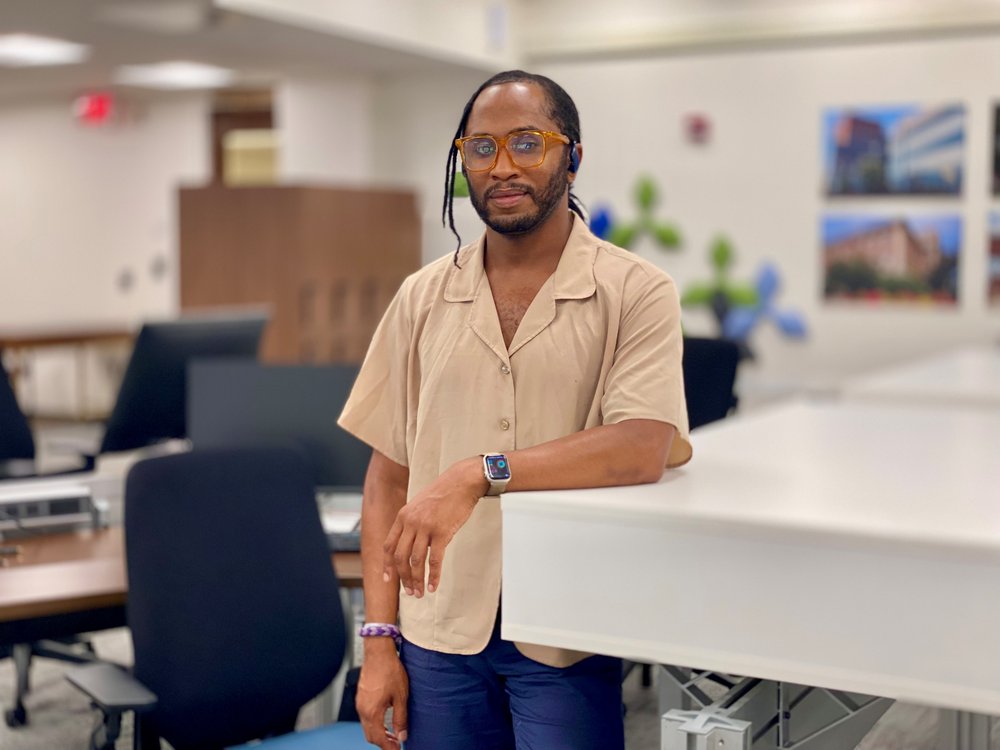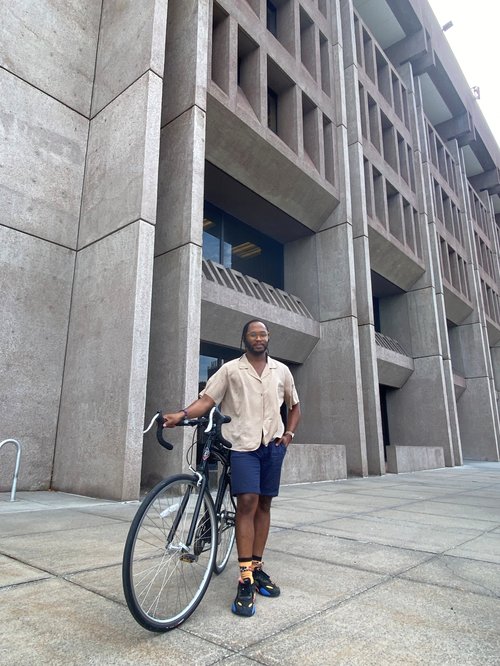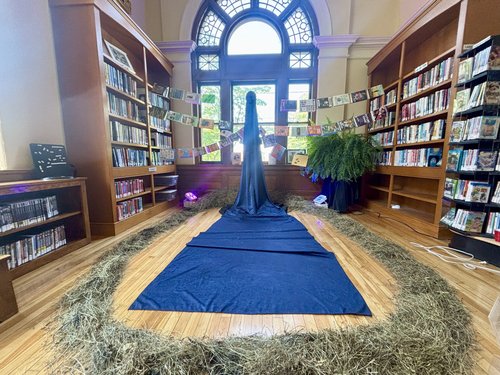Chaz Barracks, VPA postdoctoral fellow, fuses scholarship and art in motion

In the heart of Syracuse University’s Bird Library, the Mower Faculty Commons (Room 548), buzzes with interdisciplinary energy. This 5,000-square-foot space, designed for faculty collaboration and creative exploration, became the incubator for a groundbreaking research project led by filmmaker, faculty member, media scholar and postdoctoral fellow Chaz Antoine Barracks. The project was an outgrowth of his fellowship at SU, where he is part of a program to bolster the overall strength and size of the cohort of postdoctoral scholars at the University, an important factor in the Carnegie R1 designation for research institutions.
Barracks routinely pedaled through the streets of Syracuse along the green bike lanes built by SU’s Connective Corridor, arriving at the Commons where his research and teaching took shape amidst the dynamic environment. The space is designed to foster creative collaboration, and there he struck up conversations about his scholarship with Linda Dickerson Hartsock, Strategic Initiatives Advisor at Syracuse University Libraries and founder of the Blackstone LaunchPad. That journey, and the collaboration that ensued, exemplifies the spirit of innovation and cross-disciplinary synergy that the Mower Faculty Commons was established to foster.

Opened in January 2022, the Commons was envisioned as a central hub for faculty to engage in informal meetings, research collaborations and academic discussions. With its variety of seating arrangements and meeting rooms, it provides an ideal setting for projects like Barracks’, where creative minds converge to push the boundaries of research and scholarship.
From biking to Bird Library through the challenging Syracuse winters came a project that had Barracks coasting along Main Street in rural Homer, NY, with a GoPro strapped to his helmet and a microphone clipped to his bike. For Barracks, these moments were art fused with scholarship and the heartbeat of a project that began as a personal reflection and evolved into something more.
During his 2025 summer Artist in Residency at the Center for the Arts of Homer, Barracks launched Mic on a Bike, an experimental digital storytelling project grounded in the slow rhythm of rural life. His approach was simple but deeply intentional. He mounted a microphone and camera on his bike and rode through town, capturing conversations, lived experiences and everyday reflections as meaning. Through it all, he brought with him the tools of his craft: an interdisciplinary eye; a joyful aesthetic; and a scholarship rooted in what he calls “Everyday Black Matter,” which is his scholarly lens and a way of capturing the aliveness and salience of Black life.
Barracks holds a Ph.D. in Media, Art and Text from Virginia Commonwealth University, where his interdisciplinary scholarship and creative practice began to take shape at the intersection of Black queer studies, performance and digital storytelling. His work is rooted in the belief that scholarship and art are not separate pursuits but mutually enriching practices. Barracks has developed a distinctive voice through projects that merge podcast-style interviews, photography, short film and public installations to explore identity, memory and community.
Before coming to Syracuse, he held positions at the University of Richmond and the University of Pennsylvania’s Annenberg School for Communication, where he taught courses in communication departments, Media, Culture and Identity, and more specific to his research, “Black Joy, Aesthetics, and Critical Media.”
As a postdoctoral fellow and faculty member at Syracuse University, he continued to build a powerful and evolving body of work that embraces media-making as both inquiry and intervention and as an artistic and intellectual practice deeply attuned to lived experiences.
From Bird Library to Homer, NY
For Barracks, choosing Homer, a small, historic town at the gateway to New York’s Finger Lakes was not a detour from his work but a deepening of it.
“Often, artists are encouraged to think they need to circulate in New York or L.A. in order for to be seen,” he says. “But I’ve learned about myself, especially since the pandemic, that I feel most alive when I can make and theorize visual culture in places that provide intentional opportunities to slow down and engage with nuanced lived experiences.”
He was drawn to the Center because it represented what he calls “a big, vibrant art center in a beautiful, small, slow town.” A beautifully restored 1892 former church complex housing multidisciplinary programming, the Center is equal experimental, communal and rooted in place. That vibe resonated with Barracks and his Everyday Black Matter practice, which started in Richmond VA five years ago.
The Center, which hosts more than 150 events annually that attract more than 25,000 people, was created by neighbors who acquired the structure that sits at the corner of the Village Green more than two decades ago. Together, they created a nonprofit visual and performing arts center and grew it into a creative and economic anchor, attracting audiences from across the country and putting the Center on the cultural map.
“I appreciate that kind of grassroots arts activism,” says Barracks.
He also embraced the Center’s openness to experimentation and their approach to his residency, through a nontraditional lens. “There’s something really special about engaging through an aesthetic, where people see each from different perspectives each day,” he reflects. “It inspired me to think about how everyday life contributes to what I term the speculative spectacular of both art and life.”
The Center’s mission as a hub for arts-based innovation and civic engagement found clear alignment with Barracks’ work. Dickerson-Hartsock is also a founder of the Center of the Arts, helping create, fund and program it since its origins in 2001. She was also the former executive director of the Connective Corridor that helped build the green bike lanes that Barracks used daily in Syracuse. After meeting Barracks at the Mower Faculty Commons while both were working there and discussing his scholarship and vision, she helped shape his residency at the Homer Center. As she puts it, “Chaz brings a kind of artistry and scholarly depth that does not just produce work. It shifts how we think about place, storytelling and the role of art in connecting community.”
The residency was built on the central tenants of creative placemaking: connecting community by using arts and culture for activation; fostering belonging and encouraging dialogue by involving residents as co-creators; and sparking conversations about identity, history and shared values that invite more inclusive, meaningful engagement.
Active Scholarship
Barrack’s residency also built on two other frameworks, the slow movement and bike culture. The slow movement, with its emphasis on intentionality, sustainability and a more mindful pace, offers a compelling framework for rethinking practices across domains. Slow scholarship challenges the institutionally driven culture of academia by advocating for depth over speed and collaboration over competition. It values the time and space necessary for intellectual engagement, fostering research that is thoughtful, ethical and grounded. Similarly, bike culture embodies slow principles in motion. By moving through the world at a human scale, cyclists engage more deeply with their surroundings. Together, slow scholarship and bike culture illustrate how intentionally slowing down can be a form of resistance and power, while reconnecting us with place, purpose and each other.
Barracks is no stranger to this kind of slow observation that turns the ordinary into the extraordinary. His 2020 short film Everyday Black Matter, an award-winning visual meditation on Black life and joy in Richmond, Virginia, blended documentary footage, oral histories and expressive movement as a kind of radical witnessing.
“That project emerged from a moment of rupture, the isolation of the pandemic and national grief. It turned a camera toward Black artists in that community who wanted to speak on their own terms. We just gave them the camera and hit record,” he says. “People danced, wore their do-rags, did their thing. It was about self-representation in storytelling about our collective experience and a form of freedom.”
Mic on a Bike carries forward that aesthetic, with intimacy and celebration, only this time, on two wheels.
“Biking is joy for me,” Barracks explains. “It is how I decompress. It is how I think in nature, and it’s how I get from point A to B. I brought that perspective to Homer, and infused my daily rides with knowledge-sharing and community, fusing art, culture, history, memory, hopes, dreams with everyday life.” The rides became more than conversations. “They became moments of speculative connection, observation and shared humanity in my work. For me, it was an experiment in how small towns become a canvas for storytelling that bridges gaps and explores things we do not know about others who live in our own community.”
Although Homer is a small town, Barracks was interested in its layers of meaning. Once a stop on the Underground Railroad, it holds deep historical resonance, particularly in conversations about Black freedom through movement and mobility. It is among the largest and best-preserved historic districts in New York State.
Being a multidisciplinary artist engaged in storytelling through media-making tools, Barracks played DJ sets at the Homer Farmers Regional Market that included poetry and narrative that explores Black joy and pleasure through sound, and he spun a set at the Cortland Corset Building, another pivotal arts space in the community.
His residency culminated in a multimedia public exhibition at the Phillips Free Library, where Barracks immersed himself in the town’s cultural texture. He collaborated with the library to present an experimental multidisciplinary installation that served as an extension of his scholarly research, his residency work and a celebration of community storytelling. The exhibition featured his 2020 short film alongside reflections from new video footage, audio recordings and visual material gathered during his time in Homer. It included an installation of an iconic du-rag featured in his 2020 film, along with curated books from the library’s collections on both Black and queer history. After the presentation, he spun a DJ set creating a first-ever multimedia “after dark” experience with ethereal stage lighting and turned the library into an experimental art gallery for a one-night pop up.

From Main Street to Imagining America
Barracks’ approach to art and scholarship is shaped by more than just experience. It is deeply grounded in the national public arts consortium Imagining America (IA), which promotes democratic civic engagement through the arts and humanities. A longtime participant in the consortium, Barracks is a recipient of their Stories of Change public scholarship project and will be a part of 2025 IA gathering in New Mexico this fall.
His connection to Imagining America runs deep. “It modeled for me a kind of unapologetic interdisciplinarity,” he explains. “It showed me that art, scholarship and activism do not have to be in separate lanes. They can overlap. They should overlap.”
It is no coincidence that Syracuse University, his current academic home, played a foundational role in Imagining America’s development through former Chancellors Kenneth Shaw and Nancy Cantor. From 2007 to 2017, SU housed the national consortium and helped shape its identity. Initiatives like the Connective Corridor and Near Westside neighborhood projects emerged from that vision, blending art with equity and place-based engagement.
“Syracuse wasn’t just at the table,” Barracks says. “It helped set the table with the University’s vision.”
Life in motion
Barracks is currently editing the footage and audio captured during Mic on a Bike with a team of SU student filmmakers. He sees it as part of a growing digital archive, one that began with Everyday Black Matter and continues to evolve.
Moving forward, he is interested in how media can serve as both artifact and act, capturing presence, asserting worth and reflecting cultural memory in motion. “Biking itself is a mobile meditation,” he says. “It reinforces a key tenet of my work which is embracing the image as profound proof of life.” And, by situating himself as both observer and participant in the frame, Barracks breaks the fourth wall of traditional documentary practice. “This is not just about recording others,” he says. “It’s about showing up fully as myself: Black, queer, neurodivergent, joyful, imperfect.”
He envisions this residency in Homer as the launchpad for future iterations of Mic on a Bike in other towns and communities across the country or around the world. His goal is to continue to teach and publish, as he fuses his scholarship and creative endeavors. And to keep making work that expands the definition of active scholarship, whether from the lecture hall or gallery, the porch or street, or “third spaces” where community is created.
“This residency was the next adventure on a journey grounded in the belief that life is an invitation to listen, to see and to understand that even at its slowest, it is always joyful and always in motion.”
